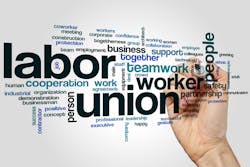DOL is Pushing for Unions, But Will This Happen?
There is a concerted effort by the White House to make sure that workers are supported as they try to organize. Over 20 government agencies are working with the White House Task Force on Worker Organizing and Empowerment to promote the administration’s support for "worker power, worker organizing and collective bargaining."
On Feb. 7, 2020, the Department of Labor issued specific recommendations including:
- Ensuring workers know their organizing and bargaining rights.
- Protecting workers who face illegal retaliation when they organize and stand up for workplace rights.
- Establishing a resource center on unions and collective bargaining.
- Shedding light on employer’s use of anti-union consultants.
- Collecting and reporting more information on unions and their role in the U.S. economy.
- Advancing equity across underserved communities by supporting worker organizing and collective bargaining.
The Secretary of Labor Marty Walsh is a labor leader from way back. He joined the Laborers' Union Local 223 at age 21 and served as the union's president until he became the mayor of Boston in 2014. He is very supportive of workers’ right to bargain and had this to say about the issue, in a statement. “The U.S. Department of Labor will play a critical role in helping the White House Task Force on Worker Organizing and Empowerment to achieve its mission. Workers today are demanding more from their jobs, and we know the freedom to exercise their right to collective bargaining is a key component of our efforts to improve working conditions across the economy,
“The report’s recommendations put the federal government’s policy of encouraging worker organizing and collective bargaining front and center and empower workers to build a stronger economy and better quality of life for them and their families,” the Secretary added.
Recent Union membership Report
According to the Bureau of Labor Statistics, in a report on January 20, 2022, the percentage of wage and salary workers who belonged to unions was 10.3% which was down from 2020 which was 10.8%.The BLS said that the 2020 number was high “due to a disproportionately large decline in the total number of nonunion workers compared with the decline in the number of union members.”
The agency points out that the 2021 rate is the same as the 2019 rate.
The report noted that in 1983, the first year for which comparable union data are available, the union membership rate was 20.1% and there were 17.7 million union workers.
Digging a little deeper into the current data, the private-sector unionization rate declined by 0.2 percentage point in 2021 to 6.1%, slightly lower than its 2019 rate of 6.2%.
Wake-Up Call?
Could these numbers raise due to the general state of employment that exists today?
Well one group, the Economic Policy Institute, which is a nonprofit, nonpartisan think tank that was created in 1986 “to include the needs of low- and middle-income workers in economic policy discussions,” believes that removing barriers to union organizing,would create a more equitable economy.
On Jan. 20, they issused a press release entitled, "Latest data release on unionization is a wake-up call to lawmakers,” in which they said: “The substantial level of union activity in 2021 (including organizing drives and strikes), along with polling data showing the large share of workers who would like a union at their workplace, demonstrate that workers want and value unions.
"The fact that unionization nevertheless dropped in 2021 is a glaring testament to how broken U.S. labor law really is and how urgent it is that Congress pass the Protecting the Right to Organize (PRO) Act."
Don't Go Backwards
Richard Epstein, a senior fellow at the Hoover Institution, a public policy think tank that “seeks to improve the human condition by advancing ideas that promote economic opportunity and prosperity, while securing and safeguarding peace for America and all mankind,” doesn’t agree with the Administrations’ push to increase unions.
In a recent article he said the following:
Unions are monopoly institutions that raise wages through collective bargaining, not productivity improvements. The ensuing higher labor costs, higher costs of negotiating collective bargaining agreements, and higher labor market uncertainty all undercut the gains to union workers just as they magnify losses to nonunion employers, as well as to the shareholders, suppliers, and customers of these unionized firms. They also increase the risk of market disruption from strikes, lockouts, or firm bankruptcies whenever unions or employers overplay their hands in negotiation. These net losses in capital values reduce the pension fund values of unionized and non-unionized workers alike.
Employers, too, have become much more adept at resisting unionization in ways that no set of labor laws can capture. It is no accident that plants are built in states like Tennessee and Mississippi and that facilities are designed in ways to make it more difficult to picket or shut down. None of these defensive maneuvers would be necessary if, as I have long advocated, firms could post notices announcing that they will not hire union members, as they could do before the passage of the NLRA.
Such changes to further weaken unions won’t happen all at once. But turning the clock back to increase union power is not the answer. It will only cripple the very workers whom those actions are intended to help.
Each of these groups represents pretty entrenched viewpoints on unions, so it will be interesting to see what younger workers, who are approaching the issue of unionization from a different perspective will do in the coming years.